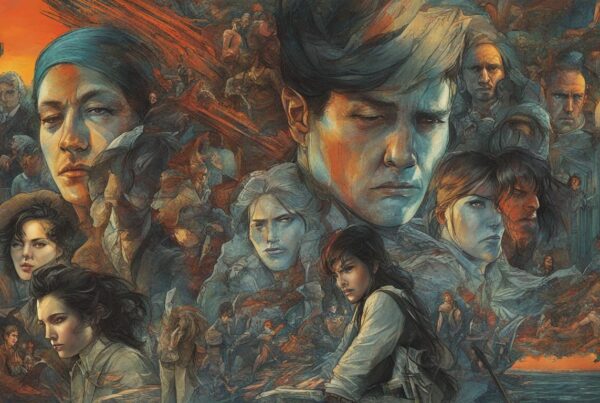In this audiobook review, we explore the intricate world of Thomas Pynchon’s Against the Day. As one of Pynchon’s most epic novels, it presents a labyrinthine narrative, complex characters, and a world of intrigue and adventure. This review will delve into the audiobook version, evaluating the narration, performance, and overall listening experience. Join us in this adventure and discover what makes this audiobook an exceptional way to experience Pynchon’s masterpiece.
Overview of “Against the Day”
Thomas Pynchon’s “Against the Day” is an epic adventure that takes readers on a thrilling journey through multiple continents, following a diverse cast of characters as they navigate through a world of intrigue and danger. Set in the early 20th century, it weaves together elements of science fiction, historical fiction, and more to create a uniquely complex and engaging narrative.
The novel’s central plotline revolves around the journeys and exploits of the various characters, but Pynchon uses this as a means of exploring a variety of broader themes. The story tackles issues such as politics, science, capitalism, and more, while also providing a social critique of the culture of the time.
Throughout the novel, readers will encounter a diverse cast of characters, each with their own unique personalities, motivations, and backgrounds. From anarchist bombers to globe-trotting explorers and everything in between, “Against the Day” is truly a feat of character-driven storytelling.
To get a sense of the grand scope of “Against the Day,” take a look at this brief summary:
| Genre | Epic Adventure Novel |
|---|---|
| Author | Thomas Pynchon |
| Publication Date | 2006 |
| Setting | Early 20th Century, Multiple Continents |
| Themes | Politics, Science, Capitalism, Social Critique |
| Characters | Diverse cast of characters |
With its intricate narrative structure, complex characters, and broad range of themes, “Against the Day” is a novel that demands close attention and rewards careful consideration. Join us as we explore this rich and fascinating work in greater detail.
Understanding the Narrative Structure
One of the defining characteristics of Thomas Pynchon’s writing is his complex narrative structures, and “Against the Day” is no exception. The novel weaves together various narrative threads, incorporating different timelines, perspectives, and styles, which can make reading it a challenging yet rewarding experience.
Pynchon employs nonlinear storytelling techniques, where the events of the story are not presented in a linear, chronological sequence. Instead, the reader is often presented with fragmented scenes that must be pieced together to form a cohesive narrative. Through this approach, Pynchon challenges the reader’s understanding of time, causality, and perspective, creating a rich, multilayered text.
This nonlinear structure is evident from the opening pages of the novel, where we are introduced to multiple characters and storylines, each unfolding at their own pace. The reader is asked to navigate this labyrinthine narrative, piecing together clues and making connections between seemingly disparate events and characters.
Pynchon’s approach to narrative structure in “Against the Day” is both challenging and rewarding, requiring the reader to engage fully with the text to unlock its secrets. Through this complexity, Pynchon creates a narrative that is immersive, thought-provoking, and deeply rewarding for those willing to take the journey.
Exploring the Intriguing Characters
In “Against the Day,” Thomas Pynchon has created a diverse and complex cast of characters that add depth and intrigue to the narrative. From the Chums of Chance, a group of adventurous balloonists, to Merle Rideout, a charismatic anarchist, each character has their own motivations, secrets, and quirks that make them stand out.
Notable protagonists include the Traverse family, who are at the center of the story, and Webb Traverse, the abusive patriarch whose death sparks the events of the novel. Kit Traverse, his daughter, is a feminist and socialist who rebels against her family’s traditions, while Reef Traverse, his son, becomes involved in the labor movement and anarchist circles.
Other notable characters include the enigmatic Lew Basnight, the seductive and mysterious Yashmeen Halfcourt, and the brilliant but troubled inventor, Nikola Tesla. Each character is unique and complex, with their own story arc and role to play in the larger narrative.
Pynchon’s characters are not easily distilled into simple archetypes or stereotypes – they are multifaceted and often contradictory, making them all the more compelling. Their relationships with one another are equally intricate, as they navigate the turbulent historical era and their own inner demons.
Overall, the characters in “Against the Day” are a testament to Pynchon’s ability to craft rich and complex personalities that elevate the story beyond a mere adventure tale.
Unraveling the Themes
“Against the Day” is a novel full of intricate themes that delve into various aspects of human society. The novel explores contemporary issues such as politics, science, capitalism, and much more. Through these themes, Thomas Pynchon offers a social critique of our world and our society. Moreover, Pynchon blends elements of speculative fiction, creating a unique blend of genres that is both thought-provoking and entertaining.
One of the central themes of “Against the Day” is the exploration of power structures and how they govern society. Throughout the novel, characters navigate various political systems and ideologies, highlighting the ways in which these structures shape our lives and the world we live in. Furthermore, the novel explores the impact of scientific and technological advancements on society, raising important questions about morality, progress, and the human condition.
Another significant theme of the novel is the exploration of capitalism and its effects on society. Pynchon’s scathing critique of capitalism is woven throughout the novel, with characters engaging with issues such as labor rights, industrialization, and the commodification of nature. Through these explorations, “Against the Day” offers a powerful critique of the capitalist system that remains relevant today.
The Intersection of Social Critique and Speculative Fiction
One of the most interesting aspects of “Against the Day” is the way in which Pynchon blends social critique and speculative fiction. By creating a world that is both familiar and fantastical, Pynchon raises important questions about our society and the world we live in. Through this unique blend of genres, Pynchon offers a fresh perspective on contemporary issues and challenges readers to engage with these topics in new and imaginative ways.
Pynchon’s Writing Style
Thomas Pynchon is known for his unique and celebrated writing style that is rich in complexity and sophisticated language. In “Against the Day,” Pynchon’s prose is dense, often incorporating challenging vocabulary and complex sentence structures that reward careful readers.
Pynchon’s literary techniques are a fundamental element of his style, and he employs them to great effect in “Against the Day,” enhancing the narrative and creating a sense of depth and immersion for the reader. These techniques include:
- Stream-of-consciousness writing
- Interweaving multiple narrative threads
- Use of recurring motifs and symbols
- Employing historical and cultural references
Pynchon’s writing style in “Against the Day” can take some getting used to, but it rewards readers who stick with it. The world he creates is vivid and alive, steeped in atmosphere and rich detail that immerses the reader in his intricate storytelling.
Audiobook Narration and Performance

If you’ve never experienced an audiobook before, a whole new world of storytelling awaits you. With the audiobook narration of “Against the Day,” you get to immerse yourself in the complex world of Thomas Pynchon while enjoying the added dimension that comes with a professional reading.
The audiobook version of “Against the Day” is narrated by a team of voice actors who bring the characters and story to life. The performances of the voice actors enhance the immersive quality of the audiobook, drawing you into the world of the novel. Moreover, the audio production quality is top-notch, ensuring that the sound effects and music cues that accompany the story are well-balanced and professional sounding. Therefore, with the audiobook version of “Against the Day”, you get to enjoy a well-produced and engrossing experience.
Contributions of Voice Actors
The voice actors who perform in the audiobook version of “Against the Day” make significant contributions to the overall reading experience. With their nuanced interpretations of the characters, the voice actors help bring them to life in a way that’s not possible through reading. In other words, listening to an audiobook can provide character depth that’s missed through reading. Thus, the audiobook version of “Against the Day” is ideal for those who want to deep dive into the characters’ personalities and motivations.
Audio Production Quality
The overall audio production quality of an audiobook can play a significant role in enhancing the immersive quality of the experience. The audiobook narration of “Against the Day” is no exception, with excellent sound design that adds depth and dimension to the story. The sound effects, music, and voice acting are all well-balanced, contributing to an engaging and holistic listening experience.
Advantages of Audiobooks
The advantages of audiobooks go beyond the experience itself. They’re also a great option for those who have busy schedules because they allow you to multitask while consuming literature. With an audiobook, you can listen while driving, cooking, or exercising, for example, making your day-to-day routines more enjoyable, efficient, and enjoyable.
Immersion in Pynchon’s World
Thomas Pynchon is known for his ability to create immersive worlds, and Against the Day is a shining example of his prowess in this regard. The novel is filled with atmospheric descriptions and vivid settings that transport readers to a bygone era filled with intrigue, adventure, and mystery.
Whether it’s the bustling metropolis of New York City, the sprawling plains of Colorado, or the shadowy streets of Venice, Pynchon’s descriptions are masterful in their ability to bring these locations to life. Readers can practically feel the chill of the snowy mountains, smell the salty sea air, and hear the sounds of the bustling city streets.
It is this attention to detail and sense of immersion that truly sets Against the Day apart. Pynchon’s world is one that readers will not soon forget, and the experience of being fully immersed in it is one that is sure to stay with them long after the final page has been turned.
Analyzing the Plot Twists
One of the defining characteristics of “Against the Day” is its ability to keep readers on the edge of their seats with its unexpected plot twists and turns. In this section, we take a closer look at some of the major plot twists that Pynchon employs to keep readers engaged with the narrative.
One of the most significant plot twists in “Against the Day” is the revelation of Chums of Chance Captain Webb Traverse’s true identity. Initially introduced as a young pilot with the Chums of Chance, Traverse is later revealed to be the son of the nefarious anarchist group, The Vormance. This revelation adds a layer of complexity to the character and raises questions about his loyalties and motivations.
Another critical plot twist is the fate of Reef Traverse, who disappears mid-way through the novel, leaving behind a slew of unanswered questions and suspicions. Pynchon keeps readers guessing until the end, finally resolving Reef’s story in a surprising and unexpected way.
Throughout “Against the Day,” unexpected plot twists abound. From sudden deaths to dramatic revelations, Pynchon keeps readers engaged with the narrative and eager to learn what comes next.
These unexpected turns are a hallmark of Pynchon’s writing, adding depth and intrigue to his narrative and showcasing his ability to keep readers engaged with his storytelling. As we dive deeper into the world of “Against the Day,” we come to see how these plot twists and narrative surprises contribute to the overall impact of Pynchon’s work.
Reception and Criticism
“Against the Day” by Thomas Pynchon received mixed reviews from readers and critics alike. While some hailed it as a masterpiece of contemporary literature, others found it to be convoluted and inaccessible. However, as expected with a work of such complexity, the novel has inspired spirited debate and discussion within literary circles.
One common point of praise was Pynchon’s inventive storytelling and intricate world-building, with many critics commenting on his ability to weave together a complex narrative that spans continents and time periods.
However, some readers found the nonlinear storytelling challenging to follow, and others criticized the sheer length and density of the novel, saying that it is difficult to read in one sitting.
Critical Reviews Table
| Publication | Reviewer | Rating | Comments |
|---|---|---|---|
| The New York Times | Michiko Kakutani | Positive | “An astonishing achievement and a masterpiece of postmodern literature.” |
| The Guardian | John Mullan | Neutral | “While I admire Pynchon’s ambition and inventiveness, the sheer length and complexity of the novel can be overwhelming.” |
| Los Angeles Times | David L. Ulin | Negative | “Against the Day is a bloated, overwrought mess that fails to live up to Pynchon’s early promise.” |
Despite these criticisms, “Against the Day” continues to be an important work in Pynchon’s oeuvre and a point of reference for readers interested in experimental and genre-bending fiction.
Historical and Cultural Context
Pynchon weaves historical and cultural references into his epic novel “Against the Day,” set in the early 20th-century. The novel explores the social and political landscape of this time, including the rise of industrialization, political turmoil, and new philosophical ideas. Cultural references abound as well, from the burgeoning film industry to the world of art and music.
| Historical Context | Cultural References |
|---|---|
| The early 20th-century marked a time of significant change, with the rise of industrialization and new technologies leading to rapid transformations in society. | The novel features numerous cultural references, such as the film industry, which was just beginning to emerge during this time period. We also see references to the world of art and music, as well as explorations of contemporary scientific thought. |
| Political turmoil was also prevalent during this time, with the rise of new ideologies and the aftermath of World War I shaping the social and political landscape. | Popular culture was also in flux during this time, with new forms of entertainment emerging and traditional art forms undergoing significant shifts. Pynchon weaves these cultural changes into the narrative, showcasing their impact on the characters and the world they inhabit. |
| The early 20th-century was also marked by significant scientific advancements, with the fields of physics, chemistry, and biology rapidly evolving during this time. | Pynchon draws upon these scientific advancements in his novel, exploring a range of speculative ideas and fictionalized scientific concepts. This blend of science and fiction is a hallmark of his work and speaks to the broader cultural milieu of this time. |
Against the Day is a complex and richly layered novel, and understanding its historical and cultural context is key to fully appreciating its many intricacies.
Analyzing Pynchon’s Themes
Thomas Pynchon’s “Against the Day” explores a wide range of themes that are both socially relevant and philosophically engaging. Through the lens of speculative fiction, the novel provides a compelling critique of capitalism, imperialism, and the scientific pursuits that shape the modern world.
One of the most significant themes explored in the novel is social commentary. Pynchon uses the story to highlight the inequalities and injustices brought about by capitalism and imperialism. He exposes the dark side of modernity, highlighting how scientific advancements and capitalist enterprises can lead to exploitation and oppression. For instance, the novel features characters like the Chums of Chance, a group of explorers who work for an aerospace company. The group’s “adventures” lead them through various global conflicts and exploitative schemes, exposing the nefarious underside of corporate imperialism.
Another notable theme in “Against the Day” is philosophical exploration. The novel engages with deep philosophical questions related to the nature of reality, the meaning of life, and the challenges of living in a world ruled by systems of power beyond our control. Throughout the novel, characters are forced to confront the limitations of human knowledge and the difficulties of making sense of a rapidly changing world.
Pynchon’s exploration of these themes is rich and complex, drawing on a wide range of literary and philosophical traditions to create a thought-provoking and engaging narrative experience. Through his use of vivid imagery, rich prose, and intricate plotting, Pynchon crafts a novel that challenges readers to think deeply about the world we inhabit and the systems that shape it.
Comparing “Against the Day” to Pynchon’s Other Works

Thomas Pynchon’s body of work spans six decades, and “Against the Day” is often regarded as one of his most ambitious novels. Comparing it to his other works can provide insight into his evolving style and thematic concerns.
Thematic similarities exist between “Against the Day” and Pynchon’s earlier novels. In The Crying of Lot 49, he explores themes of paranoia and conspiracy, which are also prominent in “Against the Day.” Both novels also deal with the dangers of modern technology and its impact on society. However, “Against the Day” is distinctly different from Pynchon’s earlier works in its size and scope, offering a more extensive exploration of these themes within a complex and sprawling narrative.
The stylistic differences between “Against the Day” and Pynchon’s other works are subtle yet notable. The novel’s emphasis on adventure and action sets it apart from the more cerebral and introspective “Gravity’s Rainbow,” while its blend of genres, including elements of speculative fiction, Western, and spy thriller, makes it a unique entry in Pynchon’s oeuvre.
Below is a table highlighting key similarities and differences between “Against the Day” and some of Pynchon’s other works:
| Novel | Thematic Similarities | Stylistic Differences |
|---|---|---|
| The Crying of Lot 49 | Paranoia and conspiracy | Shorter, more focused narrative |
| Gravity’s Rainbow | Dangers of modern technology | Cerebral, introspective narrative |
| Vineland | Exploration of counterculture and political resistance | Focus on familial relationships and personal histories |
Impact and Legacy
It’s no exaggeration to say that “Against the Day” has left a lasting impact on the literary world. The novel is a testament to Thomas Pynchon’s immense skill and influence, and it has garnered widespread critical acclaim and a devoted fanbase.
The lasting legacy of “Against the Day” is reflected in the numerous critical analyses and academic studies that have been published in the years since its release. The novel is an exemplar of postmodern literature and has been cited as a significant influence on contemporary writers.
Pynchon’s influence can be seen in the works of authors such as David Foster Wallace, Don DeLillo, and Jonathan Franzen, among others. His unique blend of complex storytelling, rich language, and social critique has left an indelible mark on modern literature.
The lasting impact of “Against the Day” is a testament to Pynchon’s literary prowess and the enduring appeal of his work. For readers seeking a thought-provoking and immersive experience, “Against the Day” presents an excellent opportunity to explore the intricate world of one of contemporary literature’s most influential writers.
The Audiobook Experience
Listening to “Against the Day” in audiobook format provides a unique way of experiencing Thomas Pynchon’s epic adventure. The advantages of audiobooks are numerous, from being able to multitask while listening to a book to having it read to you by expert voice actors.
But what makes the audiobook experience for “Against the Day” so special is the immersive storytelling provided by the format. The audiobook version of the novel brings the characters and the world they inhabit to life in a new, dynamic way. The atmospheric descriptions and vivid settings are heightened by the voice actors and audio production, allowing listeners to be fully absorbed into Pynchon’s world of intrigue and adventure.
If you’re looking for a way to enhance your engagement with “Against the Day,” consider giving the audiobook a try. It might just offer a fresh perspective on this complex and intricate novel.
Conclusion on “Against the Day” Audiobook Review: Final Thoughts and Recommendation
After diving deep into the labyrinthine narrative, complex characters, and immersive world of Thomas Pynchon’s “Against the Day,” we can confidently say that the audiobook version of this epic novel is a must-listen for fans of the author and newcomers alike.
The audiobook’s narration and performance by a talented cast of voice actors enhances the reading experience, and the vivid descriptions and settings transport the listener to the early 20th-century world of intrigue and adventure that Pynchon has crafted. The novel’s complex narrative structure, multifaceted characters, and blend of speculative fiction and social critique make it a thought-provoking and engaging listen.
Overall, we highly recommend the “Against the Day” audiobook for anyone looking for a challenging but rewarding reading experience. Whether you’re a longtime fan of Pynchon’s work or someone looking to explore his rich literary landscapes, “Against the Day” is a must-listen that will leave a lasting impression.



